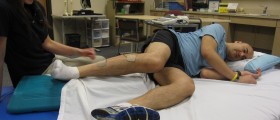
The pain is a reaction to signals transmitted through our bodies. These signals go from the source of pain and are sent via spinal cord nerves to the brain where they are processed and finally perceived as pain. There are two types of pain, first one is neuropathic and the other is nociceptive. If nerve tissue gets damaged the neuropathic pain occurs. This pain is mostly presented with burning or stabbing sensations and it is sharp. Pinched nerve is typical example of neuropathic pain. Nociceptive pain arises due to injury or some diseases not affecting nervous system. It is featured with dull ache and heavy pressure. The example of nociceptice pain is pain due to arthritis. These two types of pain can combine so the one can experience so called mixed pain.
Pain in the back can be acute or chronic. The first one is described as very sharp or dull, is usually constant and can get very severe. The location is mainly lower part of the back, with predominance on one side or in the middle. Chronic back pain is described as deep, dull and burning located in one area of the back. Sometimes it can irradiate towards legs. Additional symptoms include numbness, burning and tingling sensations sensations in the legs.Around half of all acute back pain is caused by trauma. This includes contusion, torn muscles or strained joints of the back. Beside pain muscles tend to contract and then spasms occur. These patients along with medications require rest, physical therapy or rehabilitation, prevention practices and mainly regain lost function within few weeks. Re-injury is common therefore one have to take care of his/her back. If pain occurs more than three times a year or lasts quite long so that affects regular functioning then we can discuss chronic pain. If pain intensifies, irradiates towards legs doctors should consider possible lumbar disc disease. In this case pain increases with movements and is worsened by coughing and sneezing.
The definite diagnosis of the cause of acute back pain is set after certain imaging procedures such as X-ray, CAT scan, MRI, myelogram and bone scan are done. X-ray is starting point. It can show certain changes on bones and cartilages. CAT scan is much more efficient in presentation of bone, blood and soft tissue hence is more useful than simple X-ray. MRI provides with the amazing details of spine\'s anatomy and helps distinguishing spinal disorders. Myelogram is a procedure in which nerve roots are X-rayed. This can help with discovery of some spinal states like nerve compression and disc rupture or protrusion. Bone scan can help in discovering of tumors, infections and small fractures.







-Causes,-Symptoms,-Diagnosis,-Treatment_f_280x120.jpg)









Your thoughts on this
Loading...